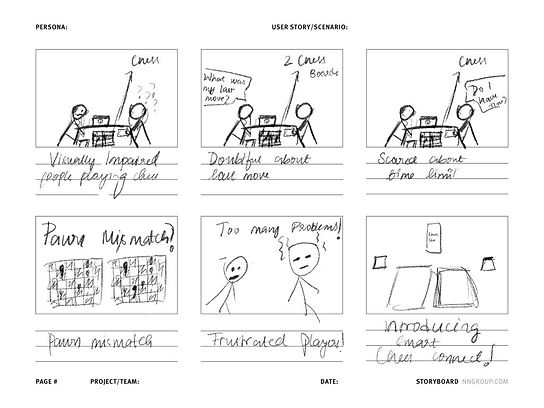
CHESS FOR VISUALLY IMPAIRED
OVERVIEW
Chess is a board game which requires two players that requires logic and careful planning. The goal of the game is to checkmate the opponent's king. Chess is a game of strategy, tactics, and planning, and it has been used to teach critical thinking, problem-solving,and decision-making skills
Team
Jayati Makhijani
Shivani kolala Jayaprakash,
Lydia Bhupathiraju(Me)
Timeline
1-2 weeks
Tools
Figma, Word, Adobe photoshop
PROBLEM STATEMENT
There are many Visually Impaired Chess players, and their equipment has remained consistent for a long period.
How can we use current technology to make chess easier for visually impaired players?
RESEARCH
How visually impaired players play chess now?
-
All the black squares are raised 3-4mm above the white squares. By feeling the squares, the player is able to determine whether the square is white or black one.
-
Each of the squares on the Board has a hole in the center so that the pieces can be fixed in these holes.
-
Each of the pieces has a downward projection (nail) at the base, which fits into the hole in the squares on the Board, thereby fixing the piece securely on the board.
-
All the Black pieces have a pin fixed on their heads helping the player distinguish between a white and a black piece.
After making every move, the visually impaired person is required to announce the move aloud, so that his opponent comes to know of the move. Instead of writing the moves on a Score Sheet, the visually impaired player writes the moves in Braille or records the moves on a tape recorder.
Reference
PROBLEMS USERS FACE
-
Insufficient time and not knowing remaining time
-
Keeping track of all moves
-
Distractions like writing down the scoresheet or recording it manually
-
Misinterpreting moves and mispronouncing steps
WHAT USERS WANT
-
Motion detection
-
Vocal commands
-
Maintain an account of all placements
-
Time Efficiency
-
Less distractions
-
Placements and Reversibility
DESIGN SOLUTION
S T O R Y B O A R D

WHAT WE ARE TRYING DO
-
We are trying to create chess sets that have an audio component that announces the moves made by the players using motion detection and vocal commands.
-
Visually impaired players can listen to the moves of the opponent and make appropriate moves.
-
They can also maintain an account of placements and go back and forth in case of doubt.
SOLUTION
Our solution have two chess boards equipped with embedded motion detection and voice command functionalities, complemented by advanced controllers featuring voice command capabilities, vibration feedback, sound patterns. All of these are interconnected to an app.
How does our solution work
-
Connection -Both the chess boards and the controller are connected through bluetooth/wifi or other connecting methods.
-
Movement Tracker- Their moves are tracked and recorded on both their devices.
-
Time Tracking - There is a vibration pattern which alerts the players every few minutes to keep track of the time without being interrupted.
-
Navigation -As the moves are already tracked by the controllers, the players can navigate their moves accordingly ( check their previous moves)
WHAT OUR SOLUTION HAS
Motion detection
Voice commands
Vibration patterns
Connection to app
Tutorials and help
Sound feedback
Timer
Customization
PROTOTYPE


FUTURE SCOPE AND CONCLUSION
Future scope of a chess board game that uses motion detection, voice command, and vibrations patterns for visually impaired people is very promising.
Motion detection technology could enable visually impaired individuals to interact with the chess board and pieces through hand gestures or other movements. This would allow for a more intuitive and natural playing experience, which could enhance the enjoyment and engagement of visually impaired players.
Voice command technology could enable visually impaired individuals to control the game using their voice, making it more accessible and convenient for those who may have difficulty using traditional physical controls. This would promote inclusive and equal participation, allowing visually impaired individuals to compete on an equal footing with sighted players.
Vibration patterns could be used to provide tactile feedback to visually impaired players, signaling moves or indicating the state of the game. This would enable visually impaired individuals to play the game independently, without requiring the assistance of a sighted person, and promote independence and self-confidence.